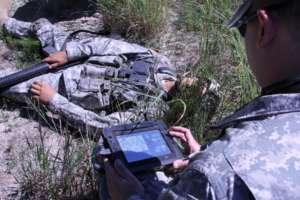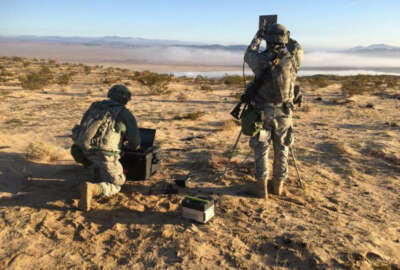
Research center shows off the future of military medicine
The Army’s Telemedicine and Advanced Technology Research Center held an open house in hopes of pairing with agencies and industry.
Best listening experience is on Chrome, Firefox or Safari. Subscribe to Federal Drive’s daily audio interviews on Apple Podcasts or PodcastOne.
The Defense Department is investing heavily in man-machine learning and artificial intelligence. And while many people think of new weapons and cyber operations as the products of this investment, the money is going to other places too.
Last week, the Army’s Telemedicine and Advanced Technology Research Center (TATRC) showed academia, industry and other government agencies that the medical field is working in the top tech fields just as much as other parts of DoD.
“Within TATRC our focus is on things that either deal with telemedicine, which is where we started, or advanced technology types of things; using computer technology, IT types of things to advance the care that’s given on the far-forward battlefield,” Col. Gina Adam, TATRC’s director, told Federal News Radio.

The research center, located at Fort Detrick, Maryland, held its fourth annual open house on Sept. 12. The goal is to demonstrate TATRC capabilities so it can pair with other agencies, universities or businesses.
“It was designed to let Army Medical Command know about the kinds of things that are our expertise, to showcase some of our mission partners, whether those are other DoD partners or industry, to show the medical command where we see research going and medical care going. We wanted to let those stakeholders know what those newest innovations were in our space,” Adam said.
TATRC currently has 19 different phase one small business innovation research agreements, three more in phase two and another three in phase three.
The phases are based on how far along a project is developed. Phase one is the most nascent, while projects in phase three are preparing for commercialization.
One of the technologies in the far future TATRC is working on has to do with drones delivering care in remote areas.
“We are looking at how we can support a medic who can’t evacuate a patient and he has a certain level of training, but he may be faced with a patient that is beyond his skill set,” James Beach, research and development program manager at the TATRC’s Medical Intelligent Systems Lab, said. “The devices [we are working on] span from near-term emergent capabilities where we are looking to provide a telemedicine capability that would essentially allow the medic to phone a friend, a doctor.”
Beach said as he looks to the future, the Army is trying to find ways to develop artificial intelligence to guide medics through procedures in cases where communications are degraded.
Beach’s team is also studying the use of drones to pick up wounded soldiers in remote and hard to reach areas and bring them home.
Drones “are not designed around the human so the constraints with the G-forces are not taken into account,” Beach said. His team is collecting data to determine safe ride standards and put restraints on the drones.
TATRC Deputy Director Jeremy Pamplin said while those far out technologies are cool, it’s important to notice the technologies that are nearer term and that may have large impacts.
“There’s a lot more going on behind the scenes both at TATRC and across the innovation domain. The robots are exciting. They are a very tactile way of looking at what the future looks like, but really the infrastructure that goes into making the robot work is where a lot more of the innovation is coming from,” he said.
The human domain, the engineering domain, the data and analysis domain and the networking domain are all areas TATRC is focusing on.
“The three technology scenarios that we demonstrated try to show, start to finish — point of injury all the way through evacuation of a combat injury — all of those pieces working together. We had subject matter experts, the combat medics, who were at the bedside of a casualty. We had our lab leads and our program managers who were there demonstrating how to piece together industry partner solutions,” Pamplin said.
Even the network experts were there to put on display electronic health records and their security.
Adam said TATRC invests in a wide variety of technologies.
“We’ve got people who are looking at things like ultra-wide band as a communication network, trying to keep in mind cybersecurity principles and how we will be able to operate in environments where we will have limited communications. We also have one of our teams that does a lot of artificial intelligence,” Adam said.
Copyright © 2024 Federal News Network. All rights reserved. This website is not intended for users located within the European Economic Area.
Scott Maucione is a defense reporter for Federal News Network and reports on human capital, workforce and the Defense Department at-large.
Follow @smaucioneWFED






